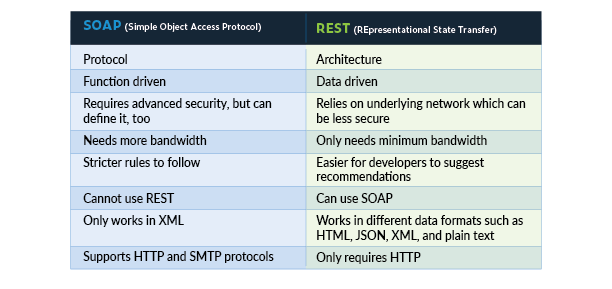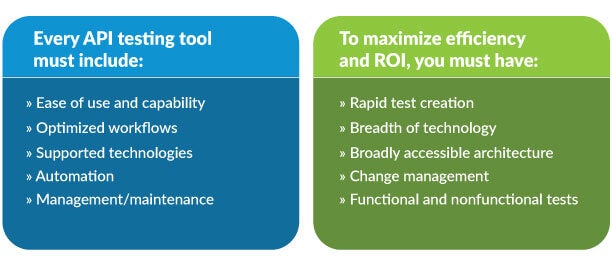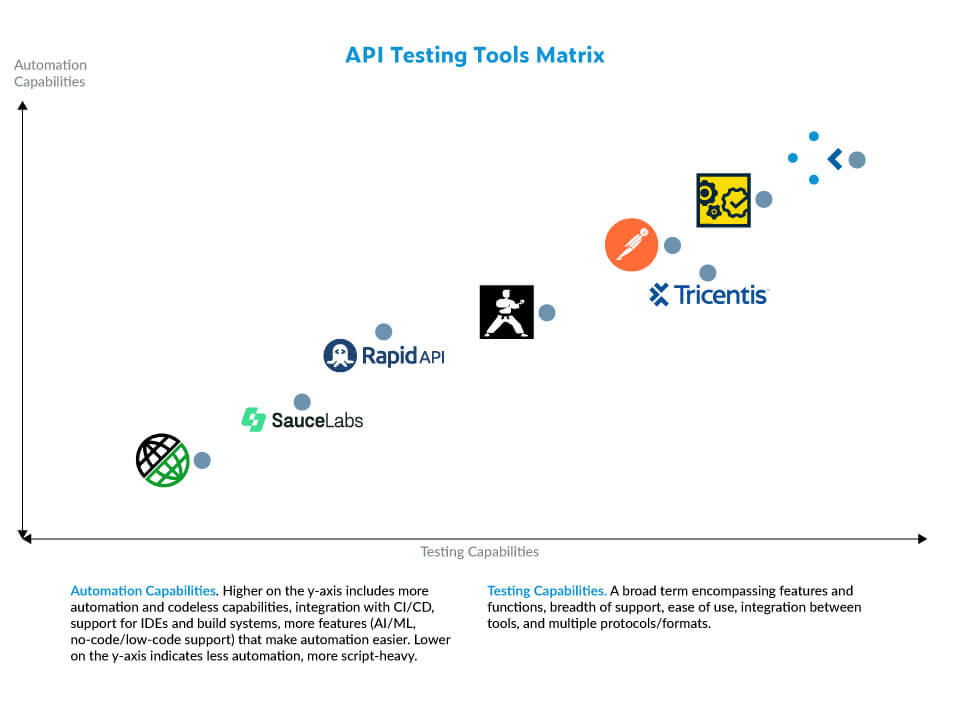
What is API Testing? Best API Testing Tools
API testing tools encompass everything from security testing to functionality testing and more. With software development incorporating APIs in an increasing manner, automation of these tests is crucial to maintain effective agile workflows.
Across web services from online banking to checking the weather app on your phone, APIs have many threat vectors. Tools on the market should address the needs of every component involved with the API. This accounts for open-source APIs, private APIs, third-party services, endpoints, and any other elements of the process.
It’s best to use tools or an integrated tool to capture the widest array of data. Find a tool or an integrated solution that can address all of the various needs of your development team. Keeping things simple means that there are fewer vectors for failure. Moreover, you’ll want tools that have CI/CD integration, allow testers to more effectively do their jobs, and fit into various test scenarios. Being able to reuse tools for multiple facets of a project is not only cost effective, but better for teams as it streamlines the testing process.
Tools like Parasoft SOAtest leverage AI and machine learning to improve testing for Agile DevOps environments. API automation testing could prove extremely useful in catching a potential problem before it becomes a full-blown catastrophe. See how Parasoft’s offerings and the other best API testing tools could enhance your processes.
This blog answers the following questions:
- What is API testing with an example?
- What are the types of API testing?
- What are the most common challenges of API testing?
- What is the best way to test APIs?
- Which tool is best for API testing?

What Is an API?
Let’s take it back to basics and describe an API and its function.
API. An Application Programming Interface that lets applications communicate and interact with each other using defined rule sets. They handle specific request types and define three parts of those requests and their expected responses.
- Data formats.
- How requests are made by users or the application.
- Rules or processes the responses must follow.
That means, as many developers know, many people use APIs within the first five minutes of getting up every single morning. Here are some examples of everyday APIs:
- Travel booking
- PayPal payments
- Weather snippets
- B2B software tool workflow automation
- Bots on websites like Twitch or Twitter
- Google Maps as used in a food delivery app
In truth, the list gets long quickly due to just how useful and versatile APIs are — especially when used in web services.
APIs vs. Plugins
Your average computer user will no doubt be familiar with the term “extension” or “plugin”. These refer to any number of software components that can alter an existing computer platform or program. The most notable example might be browser plugins like Grammarly or a screenshot extension.
APIs differ from plugins in how they function; they function as a way to define how components can interact with systems rather than acting as an addition to existing code that may change a function or feature.

REST vs. SOAP APIs & More
REST and SOAP APIs have different purposes as described above. But the differences in API types doesn’t stop there.
- Open/Public APIs. APIs that any business or developer can use. These tend to require authorization and/or authentication and can include monetization.
- Internal APIs. Private programs that usually connect data and systems within an enterprise such as HR or payroll
- Partner APIs. Licensed APIs that must be used in specific cases such as in business-to-business systems. An example would be Salesforce or AWS as they connect information to other systems. As such, security measures with partner APIs are critical.
- Composite APIs. These combine multiple APIs to create interdependent operations to provide performance or speed improvements.
Furthermore, there are JSON-RPCs (remote procedural call protocol) and XML-RPCs which use different encoding as indicated by the language prefix. While each requires diverse test catalogs, each also requires diverse toolsets, as well.
Terms like “testing restful”, “rest client”, “SOAP APIs”, or “REST API Testing” all relate to these. But REST tests and basic API functionality won’t cut it when it comes to API development and API management. Data-driven testing is a must along with automation testing tools.
Before determining which API testing tools you need, it’s best to know which test you need to prioritize. This may vary across teams since web application testing will differ from mobile testing and more.

Types of API Tests
HTTP requests comprise a key segment of testing about which every developer should know. However, due to the fact that open APIs are commonly used and many systems also use Partner APIs, security testing is paramount when it comes to common types of API testing.
Testing tools let developers review dozens of API aspects in everything from simple functions to the most significant security measures. From syntax errors and other Javascript issues to refining proprietary code for a private company, API tests must be varied, many, and occur continuously to be most effective.
There are many types of tests to run on APIs such as:
- Static API security tests review the source code of apps to find potential threat vectors in static analysis. These tests look for patterns in the code that could lead to breaches. They require static tools as they are language dependent.
- Validation testing occurs in the last stages of workflow and tests that an API is performing as expected in terms of efficiency, product, and behavior.
- Dynamic API security tests are active testing that simulates a real-world attack to find risks. These can surface from open source elements or from in-house code.
- UI testing provides insight on the end user perspective to ensure backend and frontend cohesion.
- Functional testing reviews API functions against specific situations to ensure expected results.
- Penetration testing occurs later in the workflow where non-experts review an API to find vulnerabilities.
- Load testing takes place after the entire or a part of the codebase has been executed. It reviews app functionality and performance in ideal and non-ideal conditions.
- Fuzz testing reviews how a system can handle excess “fuzz” (a large amount of data) to test for worst-case situations.
- Error and runtime testing test an API’s function against a universal codebase to find errors, resource leaks, or monitoring purposes.
- Security testing reviews how an API is insulated from exterior threats, access control design, encryption strategies, and authorization/authentication.
- Software composition analysis (SCA) reviews the dependency tree of an application then reviews it against a security risk database. If any are found, your team is alerted and you can address the issue quickly.
Make use of all of the various testing types available to ensure a more robust API. After all, you’ll need your testing tools to more than just debug or offer standard performance testing.

API Testing Tools: General Features
Every tool is different with different languages, focuses, benefits, and disadvantages. But the best tools always have a few traits in common.
- Intuitive and easy-to-use UIs
- Support for multiple validation types
- Exhaustive features
- Advanced validation expression support
- Ways to document changes, test cases, and test results
How To Pick The Right Tools For You
Selecting the right catalog of tools comes down to what functions your APIs serve and how agile you need to be. Not every API will be public or perhaps your team doesn’t use partner APIs. That means that you’ll need a different set of API testing tools.
The best thing to do is review various tools for their benefits and disadvantages to see, from a holistic perspective, which ones will help your team most. Automation plays a key role in smoothing out workflows, so tools with automated testing software elements may be more beneficial than basic options.
Asking yourself several questions can help you decide which tools are right for you.
- What’s your budget?
- Do you have domain-specific language requirements or other limitations?
- Do you need multiple format support?
- How important is seamless integration?
- What’s the knowledge level of your testers?
This is just a start. Your development team will have the insight needed to choose the right tools.

API Test Example
An excellent example of API testing would be to consider a hotel reservation system. In order to book a reservation, a hotel will ask for different information such as date of visit, room type, name, payment method, and so on. The user will typically have to validate this information and process credit card info before the booking can be complete.
Behind the scenes, a booking requires an orchestration of customer account services, scheduling services, geolocation APIs, and payment processors to complete. The end user doesn’t need to be exposed to this type of business logic, but this business logic still makes up a critical bulk of the end user experience. Accordingly, it must be validated to ensure both function and security.
An end-to-end functional API test confirms that all of the individual services are returning the right responses in the correct order without having to automate a complex UI testing script. These tests are much faster to execute and can be automated for regression testing or spun up with thousands of threads for load tests.
These aspects make potential defects within the internal working of the system easier to diagnose since it calls the APIs directly.

Most Common Challenges With APIs & Testing Tools
Every industry has its challenges and APIs are no different. While some are unique to APIs and their testing, others are ubiquitous like breakdowns in communication. Here’s a quick rundown of common challenges and their solutions.
Challenge: Setting up an API Test
Solution: Set up a test environment that includes up-to-date and accurate information from all teams. This will ensure that the API delivers expected results during a successful test.
Challenge: Sequencing API calls
Solution: Utilize visualization with regard to API calls to understand how transactions move through the application.
Challenge: Upgrading API test schemas
Solution: Incorporate comprehensive and robust testing in the alpha/beta environments. Doing so can reduce problem occurrences in production.
Challenge: Testing parameter combinations
Solution: Instead of testing on multiple fronts, select applications that won’t greatly affect operations. You can discern if any other changes should be made before a general availability release.
Challenge: Communication gaps
Solution: Instances of miscommunication or a lack of communication between development and test teams is common. However, these can lead to huge security risks or bungled releases. Utilize tools that incorporate communication, transparency, and documentation to mitigate these instances.
Challenge: Parameter validation
Solution: Verify that responses are accurate and correctly formatted to ensure proper operation. Continuous monitoring allows you to catch problems early.
How Test Automation Software Fits Into API Testing Tools
API testing is a vital part of successful CI/CD and DevOps practices, so tools with automation only make testing more comprehensive. They allow for continuous testing, more robust sets of tests, and more detailed test cases.

Best API Testing Tools
Qualifying which API testing tools are the best isn’t as simple as making a numbered list. Each tool offers a different set of capabilities, and each has its own unique focus. Choosing one isn’t going to cut it for your testing needs.
As mentioned, you’ll need to identify what your team needs in terms of features. When you’ve done that, it’s a simple task of selecting which tools best align with your needs. While there are plenty of options, we’ve gathered some of the most popular API Testing Tools for comparison below.
How SOAtest Stacks Up
One of Parasoft’s continuous testing tools, Parasoft SOAtest integrates seamlessly to bring automation to SDLC workflows. When it comes to API automation tests, SOAtest really delivers — especially in CD/CI pipelines and for popular APIs.
It carries many benefits including:
- Codeless, reusable, shareable, and robust API test generation.
- Use of automation to sync assets regularly.
- Use of AI and machine learning to create test scenarios quickly.
- Seamless integration with service virtualization and load testing.
- Easy test case updates.
- Complete end-to-end system testing.
- Continuously tests to provide up-to-date actionable insights.
- Integrates with Parasoft Jtest and Parasoft dotTEST for more coverage.
Pair it with traditional manual testing, functional tests, and performance tests (and any other API testing tools you need) for a full complement of tools to ensure top-tier performance with more hands-off maintenance.
How Parasoft Tools Can Help Your Team
Implementing automation can transform your SDLC flow from functional to high-performing. After all, since APIs and automation are both an increasing part of our future and present, API automation is a natural fit. That, in turn, means that companies will need robust testing for API performance, user interface accessibility, functional API testing, and everything in between. But there’s more to our Continuous Quality solution than AI-enhanced Selenium testing or service virtualization tools or a continuous testing framework.
Our team has the expertise and real-world experience to help you select and implement the right testing solutions for your needs. We offer webinars, whitepapers, and blogs of all kinds for every subject across multiple industries.
Since many of our clients run the gamut from security to medical to defense and beyond, our well-versed team can elucidate how best each of our test automation solutions can work for your needs.




0 Response to "What is API Testing? Best API Testing Tools"
Post a Comment